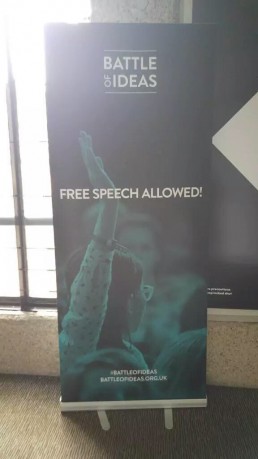The trouble with hard SF...
Traditional publishers don't like hard SF, says an author with a creative writing MFA:
 Which raises a question. As writers decry the decline of hard SF, you've got to wonder how many traditional publishers think like her - that The Martian had no market? How many reject hard SF because they think legit science is boring (or dorky) and because hard SF stories often prioritise ideas over emotions?
Which raises a question. As writers decry the decline of hard SF, you've got to wonder how many traditional publishers think like her - that The Martian had no market? How many reject hard SF because they think legit science is boring (or dorky) and because hard SF stories often prioritise ideas over emotions?
The Martian sold 35,000 copies in three months. Ed Yong - possibly the best science writer in the English-speaking world - has 70,000+ Twitter followers. And who could fail to be bored by real-life science, when it covers research topics as yawn-inducing as ground squirrel masturbation, mind-controlling parasitic fungi and rat telepathy...
Perhaps the question should be:
"Why are traditional publishers so f****g dense?"
[Hat tip: Mad Genius Club].
Do you write short SF&F fiction?
Have you had short stories published in the last few years...? If so, I probably want to hear from you.
I'm doing a bit of casual journalism - researching how the market for short genre fiction is changing. I've interviewed four writers of short fiction so far , most of whom have published upwards of 100 stories in magazines and anthologies.
I'm now investigating how Patreon might be affecting the short fiction market. If you use Patreon to fund your short fiction, have considered using Patreon, or otherwise think you can contribute to a 'journalistic' blogpost about writing SF&F shorts, I'd love to hear from you. I'm happy to 'read' back quotes and keep you anonymous, if you'd prefer.
My email address is on my professional website.
[This is what journalists do when they can't take on new projects... They do industry research into their hobbies]
New Wars, New Technology
Event China is 'not frightened to fight a war with the US', according to the Guardian today. The comments - in a state-run Chinese newspaper - came twenty-four hours after the US deployed a warship into a contested region of the South China Sea.
The territorial contest is interesting in light of a panel that I attended on New Wars, New Technology at the Battle of Ideas earlier this month. The session was blurbed as being about drones, but - for me - the most interesting idea was the prospect of war between the US and China or Russia. A so-called Great Power Conflict.
Five years ago the idea of the US fighting China wasn't taken seriously, according to Professor Christopher Coker, author of Future War. We believed that nuclear weapons made Great Power Conflict impossible. Now people believe that it's possible to fight a large-scale war without hitting the nuke button - at least in the early days. In the technothriller Ghost Fleet, for example, World War III rages for 55 days without going nuclear.
During those 55 days, a key battlefield would be in cyberspace. In a recent Pentagon wargame, according to Coker, US military systems were infected by many Chinese viruses that they had to launch their aircraft manually.
The US might also have railguns, an electrically-powered weapon that can fire metal slugs at seven times the speed of sound with a range of 100 miles, and without needing explosives. Such a weapon could transform warfare with its deadliness, range and cost to manufacture.
According to Justin Bronk, a Military Science research analyst from RUSI, the technology is fully understood, but - at the moment - we don't have the material science to build the rail and barrel. He estimates they might be in combat testing within ten years.
But what if a future war did go nuclear? According to Bronk, creating a nuclear-free world isn't an option. And here he referred to Labour leader Jeremy Corbyn, and his opposition to Britain's nuclear deterrent. An advanced superpower could rearm in three to four years - even if they killed their nuclear scientists and eliminated their knowledge of weapons - and they'd have an incentive to blow up their enemy's universities. The world would not be a safer place.
The rest of the session was about smaller wars and the ethics of drone warfare. According to Coker, 76 countries in the world today are planning to get drone technology. Worldwide defense spending on aerial drones is predicted to rise to $14 billion by 2024.
Yet drones don't need to be big or expensive. A terrorist can buy a drone off the shelf for $400, according to Coker. And - in eastern Ukraine - troops fighting Russian separatists have been equipped with 3D-printed plastic surveillance drones.
High-tech armed drones, according to Chris Woods, author of Sudden Justice: America's Secret Drone Wars, have revolutionised warfare. They provide real-time analysis of the battlefield. They also allow politicians to create a fantasy where drone airstrikes only kill bad guys, never civilians, and war is consequence-free.
Today's drones are remotely piloted by - as Coker put it - 'cubicle warriors'. And there's been controversy in the US over whether they should receive medals for valor and to what degree they can experience mental health problems - like soldiers on the battlefield.
Remotely-piloted drones, explained Bronk, rely on a satellite datalink that is vulnerable to disruption, especially when their radar X-section goes up as the bomb bay doors open. Future armed drones, such as the X-47, can fly and land themselves, and decide when to strike.
In a great power war, China would give them autonomy and - ethical issues or not - the US would be forced to lose... or follow suit.
A rare selfie
A rare selfie... taken at the Battle of Ideas at the Barbican earlier this month. I don't normally take pictures of myself, but the last fortnight is the healthiest I've felt for four years, thanks to injecting Humira in preparation for IVF.
Normal service will resume shortly...
I spent a thought-provoking weekend at the Battle of Ideas: Write up to come, but blogging has been slow.
[Image taken from @Traci_the_weeb on #battleofideas]
They're made of meat!
Kameron Hurley writes in a Q&A on Reddit:
You don’t see as much of this obsession with gore and chopping off limbs and selling wombs in my work prior to the year I started dying. It all hinges on that, on that sudden knowledge and awareness that we really are all made of meat, and that we’re kept upright, gabbling and gamboling, through a very intricate and flawed series of processes, any of which could go horribly wrong at any minute.
I empathise (not least because about half my family and friends have diabetes). On Friday, I started injecting a moderately-hardcore immunosuppressant in preparation for infertility treatment. On Saturday, I awoke with the sun on my face and the luxurious feeling of mindfulness that accompanies the first light of spring.
Overnight I'd been cured of the severe Raynaud's disease, brain fog, disturbed sleep and nagging exhaustion that has sucked my joy and productivity for about four years. Which is strange, as I don't have arthritis, lupus or any detectable autoimmune disease. The only outward signs that anything is wrong are my complete infertility, minor finger deformities, and two abnormal blood tests.
It's shocking that a single chemical - in my case overproduction of a protein called TNFa - can have such a massive impact. And yet, ultimately, we are each an intricate system. We are kept alive, moment to moment, by a complex and poorly understood series of biological processes. We are fragile. We are vulnerable. Any feeling of immortality we possess is a conceit.
The stories I find least compelling are those that trivalise suffering and death, possibly because the author is lucky enough to have no experience of either. When I read Kameron's Q&A, I couldn't help but wonder if I write gore because of a heightened sense of my own mortality.
(I should add, I'm glad that I've never had a severe health problem. And that I don't live in the United States where there is no National Health Service).
[Hat tip: Tor website]
[Title inspired by this wonderful, famous short story].
The Top 5 things you shouldn't do in a Twine game
Anyone old enough in the 1980s will probably remember the computer game Zork and the Fighting Fantasy books by Steve Jackson. They're examples of "choose your own adventure" stories where players make choices, and how the story ends depends on their decisions.
Text-based games dropped out of fashion as computer graphics improved. But now they're back, thanks to free design tools like Twine that allow non-programmers to create interactive fiction. And the sky's the limit, with Twine stories ranging from five-minute puzzles like The Tiniest Room to Morning Rituals, a game about a demonic coffee machine.
There's no right way to use Twine, but interactive storytelling has an element of game design. And that means using psychological tricks that keep players addicted to best-selling mobile games like Candy Crush or Angry Birds.
Which brings me onto my Top 5 things you SHOULDN'T do in a Twine game:
# 5 You are in a maze of twisty little passages, all alike
#5 You are in a maze of twisty little passages, all alike
You are in a maze of... F*** that, I'm off to watch the football...
Don't include a maze. Especially don't include a maze without a usable map. Most players are frustrated by going around in circles, especially circling through identical chambers.
Yes, I know mazes are easy to program and add storytelling time without needing to create additional content. But that's the whole problem. They're boring. They're irritating and no one's will hack their way through when they've the rest of the Internet to play with.
If you're going to include a maze order the rooms so the player can puzzle their way to the exit. Provide entertaining clues. Include interesting backstory when the player takes a wrong turn. Most of all, make it FUN.
I still have nightmares about the twisty little passages in Zork. This may be why I never finished Zork...
#4 It is pitch dark. You are likely to be eaten by a grue
Otherwise known as 'arbitrary death'...

Most people, playing a Twine game, don't like dying for random reasons. People feel happier when they have a strong sense of control over their lives. And you (usually) want players to be happy, right?
There are great games that rely on arbitrary death. In Dungeonquest, a recently-reprinted classic board game, you can die on turn one. But it's a party game. The whole point is onlookers laughing at your swinging blade insta-death.
If you're going to kill a player, make them think their fate is under their control. They made a mistake. They didn't level up their character enough. They threatened the drooling old lady to steal her jewels.... They didn't solve the puzzle properly. Not 'they went west'.
No one should ever die for going west...
Or fumbling their favourite colour.
#3 You walk... You walk... You walk...
Probably the single biggest way to kill player interest is 'fill screens' - pages of:
- 'You walk through a haunted glade. Dappled sunlight ripples across the ground in front of you. Look up.'
- 'Clouds of glittering fairies flock beneath the canopy. Look left.'
- 'A small pool lies ahead of you, sparkling in the sunlight. Carry on going.'
- 'There are three sheep and a goat in the field ahead. Walk ahead'.'
Put simply, you're not 'rewarding' the player.
Addictive casual games like Puzzle Craft have players repeating simple actions to gain 'prizes'. In Puzzle Craft, this might be mining or growing crops to buy better equipment to do more mining. The play-reward-play-reward cycle gives the player a sense of achievement that keeps them coming back.

Good Twine games also create a play-reward cycle. The Tiniest Room gives players prizes for looking around (a claw, a key). This encourages them to follow the puzzle through to its conclusion.
The only thing the player gains from physical description is... physical description. You can create beautiful writing but - unless the player interacts with it - you could have written 'you are in a maze of twisty little passages, all alike'.
#2 The third Sudoku in the Laundromat
One number puzzle is a puzzle. Two is an excess. Three consecutive number puzzles is death for your game. The same goes for 'Fred sends you on a quest to fetch item X. And then Hiyam sends you on a quest to fetch item Y. And then...'
There is a reason why Groundhog Day is not a utopia. Players don't like repeating the same repetitive sequences over-and-over. If you can avoid giving them the twentieth variant of the same puzzle, that helps keep things fresh.
#1 Unlock the red door with the banana
'Use the red key to unlock the red door' get boring after the tenth iteration.
'Unlock the door by stealing a cat, sellotaping toast onto its back, and lowering it out of a window, distracting a mad physicist so you can steal his sousaphone and blackmail him' is a recipe for hair-ripping frustration.
If you want to create that puzzle, you'll be in good company. There are countless articles about the most baffling puzzles in computer games.
For the benefit of American readers...
An American visited England and his Facebook post went viral:
The reason they drive on the left is because all their cars are built backwards
You can read the rest here. As someone living in England, he's 99% accurate. He's wrong about Bose speakers, but only rich people in London have them. He's also wrong about the guns. There are guns in rural areas, but they're shotguns.
![Keep Calm and Carry on Hunting... [recently sent to an American correspondent with whom I had a fascinating discussion about life in the UK].](http://www.futureslesstravelled.com/wp-content/uploads/2015/10/Keep-calm-and-carry-on.jpg)
On the subject of dogs piloting jetpacks...
Because I've got to beta test a Twine story this evening... I leave you with some deep thinking on the topic of whether dogs can - and should - pilot their own jetpacks.
Here is a video of a jetpack/wingsuit being piloted over Dubai.
I found this video while researching a scene in a short story. The whole scene eventually ended up on the cutting room floor, but the original had soldiers flying down a narrow gorge. They were accompanied by a military working dog. And I wondered, 'Would the dog have its own jetpack/wingsuit'? I knew that paradoggers existed in the Second World War and, indeed, had their own parachutes.
Belatedly, I discovered the Dubai wingsuits weigh 55kg; five times that of your typical springer spaniel. A dog piloting a wingsuit wasn't feasible in hard SF without a major improvement in material science. With a sign of disappointment, I strapped the paradog to its handler and my characters breathed a (fictive) sigh of relief. They know dogs as well as I do. Almost every year, one American is shot by their dog.
A dog with a jetpack would only make trouble with the damn thing...
The Two Cultures of Hugo short stories
Lela E. Buis argues that hard SF writers are in danger of extinction, even in their traditional home of Analog magazine. She says:
Does staying within the confines of science really limit creativity? Cixin Liu has refuted this one. He’s written something very creative within the limits of current physics. So what’s the problem with Analog’s stories? My thoughts? They’re not written by brilliant scientists any longer.
As a hard SF writer with a geophysics PhD, I decided to investigate who was writing award-nominated short fiction. So I looked up the degree subjects of Hugo short-story nominees from 2012, 2013, 2014, 2015, and - for comparison - 1967.
The results were remarkable. In 2014, two out of the four short fiction nominees had an MFA or PhD in English or Fiction. Only one of the nominees had a science background. In 2013, two of the three nominees had a first degree in English.
The year 2012 was slightly more diverse, as John Scalzi has an undergraduate degree in philosophy and Nancy Fulda has an MA in computer science, but the ballot still had a BA in English Literature and someone with a BA in English (and biophysics).
Compared to 1967, the difference was striking. Only one of the eight 1967 nominees had a BA in English. Most of them didn't even appear to have degrees, and four had been in the US Army, Navy or Airforce (suggesting a technical background).
It's no surprise that a bunch of English Literature graduates and professors are more interested in literary styling than in scientific ideas or technical social speculation. And, going by the reaction of literary writers on my MFA program to my short fiction, they don't find hard SF engaging - unless the writer also delivers an emotional punch, deep characterisation and perfect prose.
I can't help thinking of C.P. Snow's 1959 lecture The Two Cultures, which argued that humanities and science are separate cultures, and their separation is an impediment to Western society solving its problems. The cultural divide is deep seated. As Simon Critchley is quoted on Wikipedia:
[Snow] diagnosed [...] the emergence of two distinct cultures: those represented by scientists and those Snow termed 'literary intellectuals' on the other. If the former are in favour of social reform and progress through science, technology and industry, then intellectuals are what Snow terms 'natural Luddites' in their understanding of and sympathy for advanced industrial society.
In short, 'literary intellectuals' don't write hard SF because they've nothing to say about the future. They're concerned with the beautiful arrangement of words, and not new ideas. They're a cultural dead end in science fiction. And, yes, if that sounds prejudiced, it is...*
*(or maybe I'm just provoking a little :) ).
[My data can be downloaded here].










